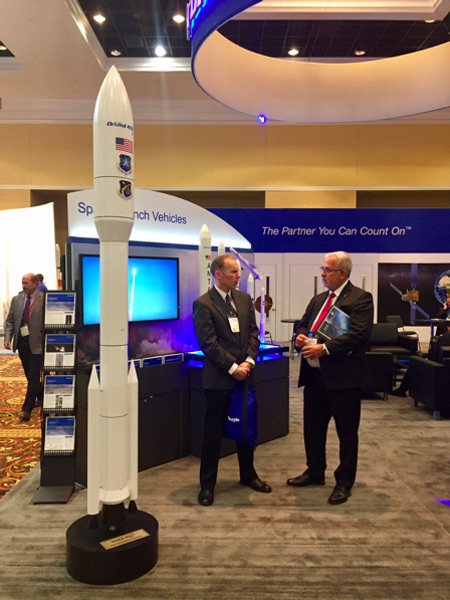Orbital ATK seeks a starring role in military space launchesby Jeffrey L. Smith
|
| Even if Orbital ATK is selected for the next round and successfully flies the NGL, that won’t guarantee them a place launching the US military’s satellites. |
At the Space Symposium, national security applications for the new rocket were front and center, leaving no doubt about the rocket’s intended market and the identity of the project’s patron, the US Air Force. These launches pay the most, but that also guarantees intense competition from companies like United Launch Alliance (ULA), previously the sole provider of such services; and SpaceX, whose aggressive pricing and business tactics have already won it 2 contracts to launch GPS satellites and one for the National Reconnaissance Office. After proposals are submitted later this year, the USAF is expected to pick three companies in 2018 to further develop and fly their proposed rockets.
Even if Orbital ATK is selected for the next round and successfully flies the NGL, that won’t guarantee them a place launching the US military’s satellites. That won’t happen until a final round that selects just two companies to proceed with production. With test flights of the NGL scheduled to take place no sooner than 2021, Orbital ATK won’t know for years whether or not the NGL will be selected. And so the auditions—convincing the fickle defense community that the NGL is the right rocket for the role—will continue for years to come.
Orbital ATK emphasized national security as the principal mission for the NGL and its “commonality” with their other rockets. With slogans like “A New American Launch System for National Security” that is “capable of launching national security, science and commercial payloads,” Orbital ATK was performing for the most important member of the audience: the producer. Science and commercial uses were always listed as subordinate to national security needs, if they were mentioned at all. To help assuage any concerns about an unconventional three-stage design, Orbital ATK reiterated that “common systems [propulsion, structures and avionics]” would “result in lower technical risk and cost savings to customers.” If the NGL can back up these promises with results, it might just get the chance to perform on one of the most visible stages in the world.
They don’t build ’em like they used to
In addition to giving new details about the NGL, Orbital ATK also released the first images of the proposed rocket. While much of this confirmed what was already known (see “Orbital ATK, CRS-2, and the return of ‘The Stick’”, The Space Review, November 7, 2016) there was enough new material to provide greater insight into Orbital ATK’s future plans. Some of the changes were slight: “Next-Generation Launcher” became “Next Generation Launch,” while other news was more meaningful, such as a version that was more powerful than the current reigning champion for large rockets, the Delta IV Heavy (as is true with both the Defense Department and NASA, you can change the name to anything you want, as long as the acronym stays the same). None of this, though, changes the fact that the NGL’s three-stage design and heavy reliance on large solid motors is quite unorthodox and would make it the only such rocket in the world to launch large satellites.
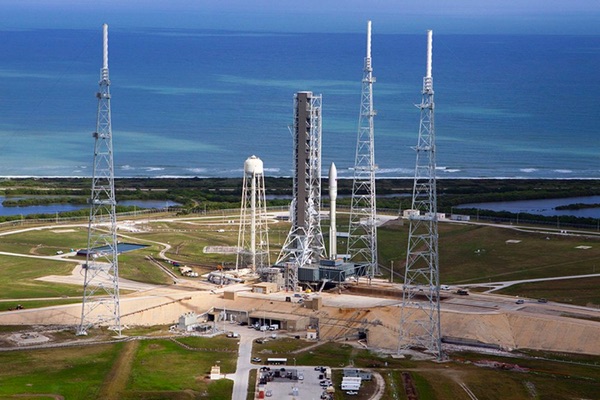 Artist’s depiction of an NGL 521 at Kennedy Space Center. (credit: Orbital ATK) |
Like most modern rockets, the NGL isn’t intended to be a single, one-size-fits-all rocket, but instead a family of rockets with variants able to launch a variety of payloads, from light to heavy and small to large. The first in the family to make its debut will be the NGL 521. The numbering scheme is a nod to the Atlas V, an incredibly successful rocket the Air Force would gladly continue using but for its Russian engines, and the very rocket Orbital ATK would like to replace with their Made-in-the-USA design.
| Even if there is no intent to use all of these variants, Orbital ATK is reinforcing to the military and other customers the similarity of NGL to the highly-regarded Atlas V. |
In that three-digit code, the first number refers to a five-meter diameter nose cone and determines the maximum size of the satellite being launched. The second value (2, in this case) is the number of GEM 63XL booster motors attached to the first stage, and can vary from zero to six (Orbital ATK’s marketing department loves using “XL” for stretched versions of their rockets as evidenced by the Pegasus XL, Taurus XL, and a number of XL motors.) The last number refers to the number of engines on the third stage: usually just one, but it can be increased to two for double the thrust to lift the absolute heaviest payloads. Even if there is no intent to use all of these variants, Orbital ATK is reinforcing to the military and other customers the similarity of NGL to the highly-regarded Atlas V.
Orbital ATK also confirmed they will be adding two (and later a third) motors to their Castor line: the Castor 300 and Castor 600, for the initial NGL’s second and first stages, respectively. These will later be joined by the Castor 1200 when the first stage is doubled in size to create the NGL XL (there’s that XL again.) Modern Castor motors are named for the approximate weight of the motor in thousands of pounds. Thus, the existing Castor 30 comes in at an impressive 30,000 pounds (13,600 kilograms). But this will be dwarfed by the newest members of the Castor family, the largest of which will weigh 1,200,000 pounds (544,000 kilograms)!
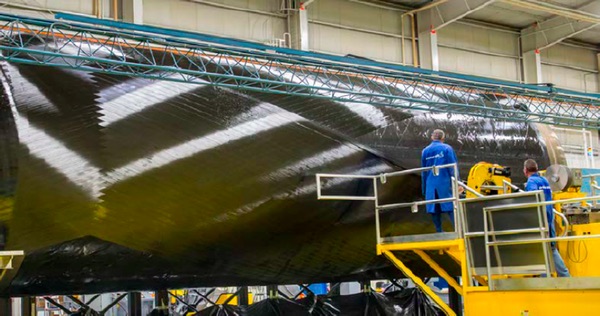 Like other Orbital ATK rockets, the NGL will use composite rocket motor cases wound on fixtures to reduce weight and lower cost. (credit: Orbital ATK) |
To control the cost of the new Castor rocket motors, as well as the rest of the NGL, Orbital ATK is leveraging technology developed from their other motors and rockets. For example, these Castor motors are updated versions of the Space Shuttle’s Solid Rocket Boosters (SRBs) that trade metal cases and PBAN-based propellant for lightweight graphite composite cases and higher performing HTPB-based propellant. Modernizing these components will both reduce cost and increase performance.
Orbital ATK has also said they will reuse avionics and large structures from other rockets as well. This refers to Orbital ATK’s Module Avionics Control Hardware (MACH) system already used by rockets like Minotaur and Antares. The structures are those built at their Iuka, Mississippi facility, from which nose cones and other composite pieces are barged down the river for use on Delta and Atlas rockets. Orbital ATK is even experimenting with carbon nanotube structures that better dampen violent rocket vibrations.
When all of these upgrades are combined with a high-energy upper stage, the NGL 562XL (XL again!) will be able to lift more than the biggest rocket in the military’s inventory: the Delta IV Heavy. But, while most of the news from the Space Symposium revealed new details about the NGL, Orbital ATK actually made the design of said upper stage less clear. The third stage will still use high-performance liquid hydrogen and liquid oxygen for its propellants and will be of Orbital ATK’s own design, but which engine will power this new stage has yet to be decided.
Orbital ATK has experience designing this kind of stage. For example, their Thunderbolt concept featured a third stage with dual RL10s and a five-meter nose cone. This was part of Orbital ATK’s aborted contribution to the Stratolaunch system, and the NGL will “coincidentally” have the same configuration.
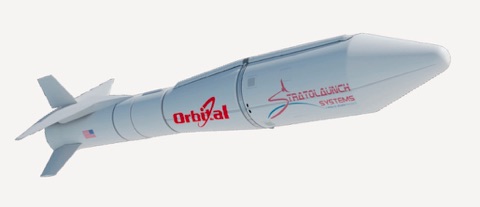 Orbital ATK’s Thunderbolt concept was the basis for the NGL’s upper stage. (credit: Orbital ATK) |
Previously, Orbital ATK had indicated a preference for Blue Origin’s BE-3, going so far as to secure funding from the Air Force to develop a nozzle extension to improve its performance. Orbital ATK now says the final engine selection hasn’t been made, opening the door for Aerojet Rocketdyne’s RL10. Both of these engines have advantages and disadvantages, with neither being the clear-cut choice. The RL10 is a low-risk engine with all of its bugs having been worked out over 55 years of use. Also, NASA has a vested interest in continuing production of the engine, since they’ve chosen to use four of them to power the upper stage of their massive Space Launch System (SLS) rocket. Orbital ATK can expect the price of their engines to be subsidized by NASA’s larger contract.
On the other hand, the BE-3 engine has much less flight experience on Blue Origin’s New Shepard suborbital rocket. Blue Origin is promising low prices for the engine, but early users of the engine can expect more technical risk. Again, Orbital ATK should expect to have the price of this engine subsidized as it will be used on Blue Origin’s New Glenn rocket (and Jeff Bezos’ sizable checkbook) and eventually on ULA’s Vulcan, but it will be many years before either of these rockets are able to prove the BE-3’s reliability. It isn’t known whether Orbital ATK’s current indecisiveness is born from real concern about the BE-3’s technical merits, or if a decision has already been made and this is just a negotiating tactic to lower the final price.
Speaking of price, Orbital ATK has carefully selected upgrades and technologies so the NGL will fit inside the military’s budget. Successful performance used to be the only criteria, but in an era of constrained budgets and aggressive pricing, cost is becoming ever more important. Orbital ATK is targeting a price below $100 million per launch. But this is certainly the list price for the simplest version. Military launches bring extra security and mission assurance requirements that drive up cost. ULA’s venerable Atlas V has gone through considerable cost cutting to reach its current $109 million list price, but their RocketBuilder website reminds users, “pricing does not include all services required for full U.S. Government compliance. The price for these services typically ranges between $30M and $80M.” Even SpaceX, the low-cost leader in spaceflight, had to increase the price of their basic Falcon 9 from $62 to $92.5 million after accounting for extra US military costs.
| If the NGL can overcome these challenges, it will still be an unorthodox design. No other launch vehicle has ever used two solid stages topped with a liquid hydrogen/liquid oxygen upper stage. |
Orbital ATK can’t compete directly with either ULA’s perfect record or SpaceX’s current ultra-low prices. Instead, Orbital ATK is emphasizing synergies with their other government work. Orbital ATK projects an overall savings of $600 million over the next ten years. The selling point is that a mass-produced NGL will create economies of scale that will save all government customers when buying military and space rockets. Even though the proposal states contracts will be awarded on “best value” and not strictly on lowest price, this will require a strategic decision on the part of the US government as budgets are segregated by government agency and further segregated by program. It would be virtually impossible for an Air Force procurement officer to defend saving money they will never see.
If the NGL can overcome these challenges, it will still be an unorthodox design. No other launch vehicle has ever used two solid stages topped with a liquid hydrogen/liquid oxygen upper stage. But, for Orbital ATK, this design makes sense as it draws on their decades of experience and utilizes facilities they already have. This unique architecture could actually be seen as an advantage by the US military, whose doctrine of “assured access to space” depends on having several independent means of launching satellites into space. SpaceX will use only SpaceX hardware on their Falcon rockets. ULA, as a traditional contractor, will integrate Blue Origin’s rocket engines on their new Vulcan rocket. If Orbital ATK uses their own solid-propellant motors and an RL10-powered upper stage, that would be a technologically independent means of launching national security payloads. While the NGL is unorthodox, its unconventional nature may actually prove to be its greatest asset.
What does the fox say?
Two thousand six hundred years ago, the Greek poet Archilochus wrote, “a fox knows many things, but a hedgehog one important thing.” In business, this adage is used to describe “fox strategies”—pursuing many goals and opportunities in different markets—and “hedgehog strategies” of focusing efforts on just one or a few opportunities to improve the chances of achieving the goal. Many business theorists prefer hedgehog strategies because they focus all available resources on a narrow goal, and remove any other distractions that might derail a business.
The space launch industry seems to agree with this, as each rocket company is focusing their efforts by reducing the number of rocket models they design and build. For example, SpaceX has a narrow rocket offering based around the Falcon 9 (going so far as to say the Falcon 1 won’t being returning) and by being ever more vertically integrated. The company has routinely switched from buying specialized rocket components made by outside suppliers to designing and building those same components themselves. SpaceX wants to focus on making rockets, which was clear from the absence of habitats in Elon Musk’s Mars plan. This focus has culminated in the construction of the company’s own spaceport near Brownsville, Texas. SpaceX is like an airline that wants to design, build, and fly their own airplanes from their own private airports.
In a similar fashion, ULA is also pursuing their own hedgehog strategy by simplifying their line of rockets. In response to new competition from SpaceX, ULA’s CEO Tory Bruno has led a drive to stay competitive by reducing their number of rocket families from 3 (Delta II, Delta IV, and Atlas V) to 1 (Vulcan). Along with reducing the types of rockets they build, ULA is also reducing their number of launch pads (from six to two) and propulsion suppliers (from five to two).
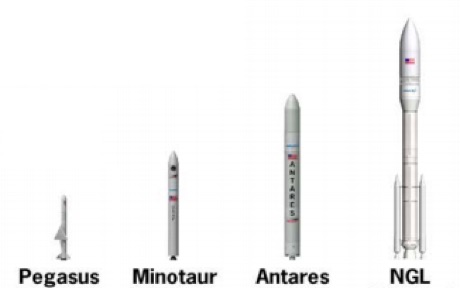 Orbital ATK’s line of launch vehicles. (credit: Orbital ATK) |
On the other hand, Orbital ATK is doing exactly the opposite: actually increasing their number of launch vehicles from three to four. The other parts of their business have similarly high product diversity, with a catalog that lists 91 individual rocket motors. A few examples from among Orbital ATK’s ten different satellite buses illustrates the diversity of size and purpose:
- Microstar: 40-kilogram, LEO-based satellites, launched from a Pegasus
- GEOStar-3: 3,500+kilogram, GEO-based communications satellites, launched from the NGL
- Cygnus: 5,300+kilogram cargo vessel to the ISS, launched on either an Antares or NGL
There is clearly a different business strategy here from other companies that are specializing in just a few products. For Orbital ATK to expand this business model to new markets and customers, they need the Air Force to fund the development of the NGL and act as the rocket’s anchor tenant. If that happens, the NGL will be the foundation for future plans and Orbital ATK’s opportunities will multiply (we don’t say explode in the rocket business.)
The stars align
Orbital ATK continues the American tradition of drawing inspiration for the names of space vehicles from astronomy and Greco-Roman mythology. With names like Pegasus, Taurus, and Cygnus, Orbital ATK finds itself among good company who draw on the aspirational nature of space (a hint at where NGL’s ultimate name will come from.) Names like Apollo and Saturn aspired to connect Earthly tasks with a heavenly destiny. Likewise, if the stars align for the NGL, Orbital ATK will transcend its role in the aerospace industry and achieve grander ambitions.
| All of this points toward Orbital ATK becoming a systems integrator, aerospace parlance for a company that puts together individual pieces to solve a larger problem. |
After they complete development, Orbital ATK may like to apply the NGL’s technology to NASA’s SLS. Orbital ATK and NASA have enough hardware to make nine complete sets of SRBs intended for SLS Block 1/1B flights (one of which was recently set aside for a museum display.) Unlike the practice during the Space Shuttle program, none of these boosters are planned to be recovered. Instead, NASA will use up the current SRB inventory and discard them in the ocean. The SLS will then be upgraded to the Block 2 variant, featuring “Advanced Boosters,” a job for which a new Castor motor would be ideally suited. The five-segment SRB could be replaced by the new Castor 1500! NASA will gladly accept the improved performance of the new booster and claim credit toward their goal of reducing costs for SLS and their Orion crew capsule by 50%.
This is not the only connection that Orbital ATK has with NASA’s Orion capsule. Previously, Orbital ATK was contracted to build the first stage of NASA’s Ares I rocket for their ill-fated Constellation program. Only the Ares V survived that cancellation as the redesigned SLS, but Orbital ATK teamed up with Astrium to pitch the idea again as the Liberty rocket, unsuccessfully. Now, the NGL could have all the lifting power it needs to launch Orion without help from outside companies, although the company has no plans to human-rate the vehicle.
Importantly, the NGL would also allow Orbital ATK to launch the heaviest spacecraft they design and build today, and even heavier payloads in the future. Orbital ATK started life designing and launching small satellites. With time, both the satellites and rockets have gotten bigger. But today, Orbital ATK’s biggest spacecraft have grown too large for their rockets. Orbital ATK has to watch as their premier satellites like their GEOStar-3 and their new Mission Extension Vehicle (MEV) are launched on other people’s rockets. While most launch contracts are competitively awarded, you lose 100 percent of the contracts you don’t have a rocket for. Worse, Orbital ATK has had to endure watching their Cygnus cargo vessel, a rocket contract they had won, be launched on the Atlas V. Not only could the NGL launch these spacecraft, but it could also even resupply NASA’s proposed space station around the Moon, as NASA has said they would consider a commercial option for resupplying the Deep Space Gateway.
All of this points toward Orbital ATK becoming a systems integrator, aerospace parlance for a company that puts together individual pieces to solve a larger problem. By merging Orbital Sciences and ATK, the newly minted Orbital ATK has the ability to provide individual pieces of a solution and put together pieces from other companies to meet their customers’ needs. The combined company sits at the center of a unique Venn diagram: the original NewSpace company with the experience of OldSpace companies; reliant on government funding yet willing to invest their own money; affordable prices to serve commercial customers yet disciplined to ensure the safety of astronauts. If Orbital ATK can leverage their unique experience and connections, they just might make their own stars align and compete on a whole new level.
Do you want fries with that?
Even though other aerospace companies are narrowing their focus, that doesn’t mean that every company has to follow the pack to be successful. Good hedgehog strategies come in many shapes and sizes. One of the keys to a successful hedgehog strategy is finding a unique value proposition, the distinctive good or service that only that particular company can provide for their customers.
| As a truly vertically integrated space company, Orbital ATK will be in the unique position to offer their customers complete space solutions. If Orbital ATK can pull this off, not only would they have a next generation rocket, but a next generation business as well. |
ULA has a premium service/premium price model whereas SpaceX has focused on a lowest-price model. But, another common strategy is bundling related products and services together to meet all of a customer’s needs. Anyone who has ever bought fast food has seen this model. McDonald’s tries to bundle their products by calling it an “Extra Value Meal.” While you may have come in for a hamburger, McDonald’s will try to cross-sell you French fries and a drink, some of their most profitable items. That’s why you’ll always hear the person taking your order ask, “Do you want fries with that?” It makes great business sense.
Clearly, the space business is different from selling burgers, but sound business practices can be applied to any enterprise. Customers don’t buy rockets just because they are cool (although they are), but instead as part of a larger effort to achieve a specific goal, be it for a commercial, military or civil government program. Achieving the customer’s goal requires a range of goods and services: a satellite, a rocket to launch it, ground equipment to operate it and distribute data, financing to pay for it all, and insurance to protect the investment of hundreds of millions or even billions of dollars. Unlike competitors such as ULA and SpaceX, Orbital ATK has all the components to provide such an integrated service.
The NGL is necessary for a bundling strategy, but it is by no means sufficient. For a company with a vertically-integrated product portfolio like Orbital ATK to successfully implement such as strategy, it needs to have a vertically-integrated business plan. Otherwise, the company is simply opening itself to a larger number of competitive markets. Offering integrated solutions to customers will require integrating efforts across the entire company, from marketing and sales to engineering and operations. In the near future it may be common to hear an Orbital ATK salesperson say, “In addition to the end-to-end system you’ve already purchased, because you selected financing and insurance through our preferred vendors you’ll receive our MEV Extended Warranty®—a $5 million value—and peace of mind knowing your investment is secure, at no extra charge.”
If the NGL lands the part with the US Air Force, not only will Orbital ATK be able to launch a whole new class of satellites, but they can also combine many of their existing business segments together. As a truly vertically integrated space company, Orbital ATK will be in the unique position to offer their customers complete space solutions. If Orbital ATK can pull this off, not only would they have a next generation rocket, but a next generation business as well. For a mere rocket to achieve so much would be the role of a lifetime.
